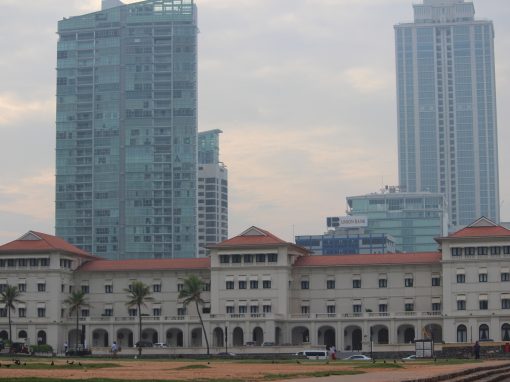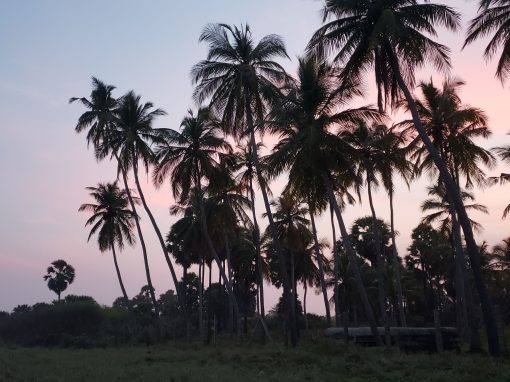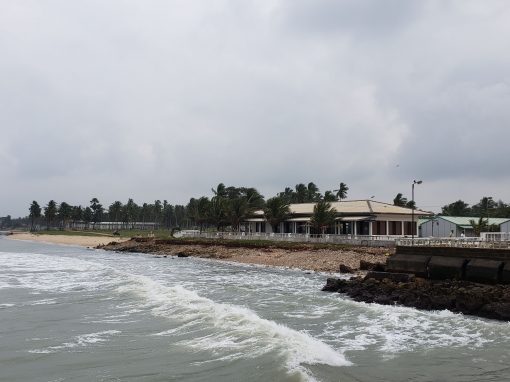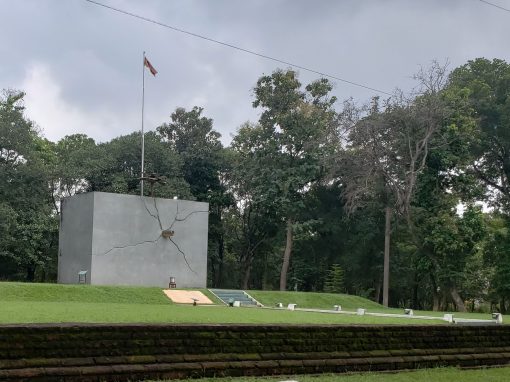Conclusion
The war memorial at Kilinochi vividly depicts a bullet cracking a slab of concrete in the name of peace. (Photo © Stephen Cook)
Highway A9 runs 321 kilometres from Jaffna to Kandy, from the heart of ancient Tamil kingdoms to the holiest Buddhist site in Sri Lanka, the Temple of the Sacred Tooth that supposedly houses ivory from the holy man himself. A9 is the only highway that connects the north through Kandy to other major cities in the south, first reopening in 2009 after 24 years cycling between full closure to limited mobility through checkstops.
No small act: besides major road repair, swathes needed to be demined. But the Sri Lankan military was up to the task, not least because it would open up their own logistical capability into the north.
When the army finally dislodged the LTTE from here in January 2009, it was the beginning of the end for the dream of a separate Tamil state. Many civilians were pressed or even voluntarily retreated with the Tigers, destined for the killing beaches of Mullaitivu. Those who remained or else returned were initially held in refugee camps.
Today, busses carry tourists from the south along the highway through Kilinochchi on their way to nearby sites of interest. From the road, it looks a bustling modern Sri Lankan city: electronic shops, ATMs, restaurants and even parks straddle the main thoroughfare in a perfect display of post-war rehabilitation.
But get off the main highway and you’ll find dirt roads amid the ruins of bombed-out LTTE administrative offices in an agricultural district still suffering through the highest district poverty head count (18.2%) in the country.
For years, foreign access to this area was restricted. But a new industry boomed almost overnight: war tourism.
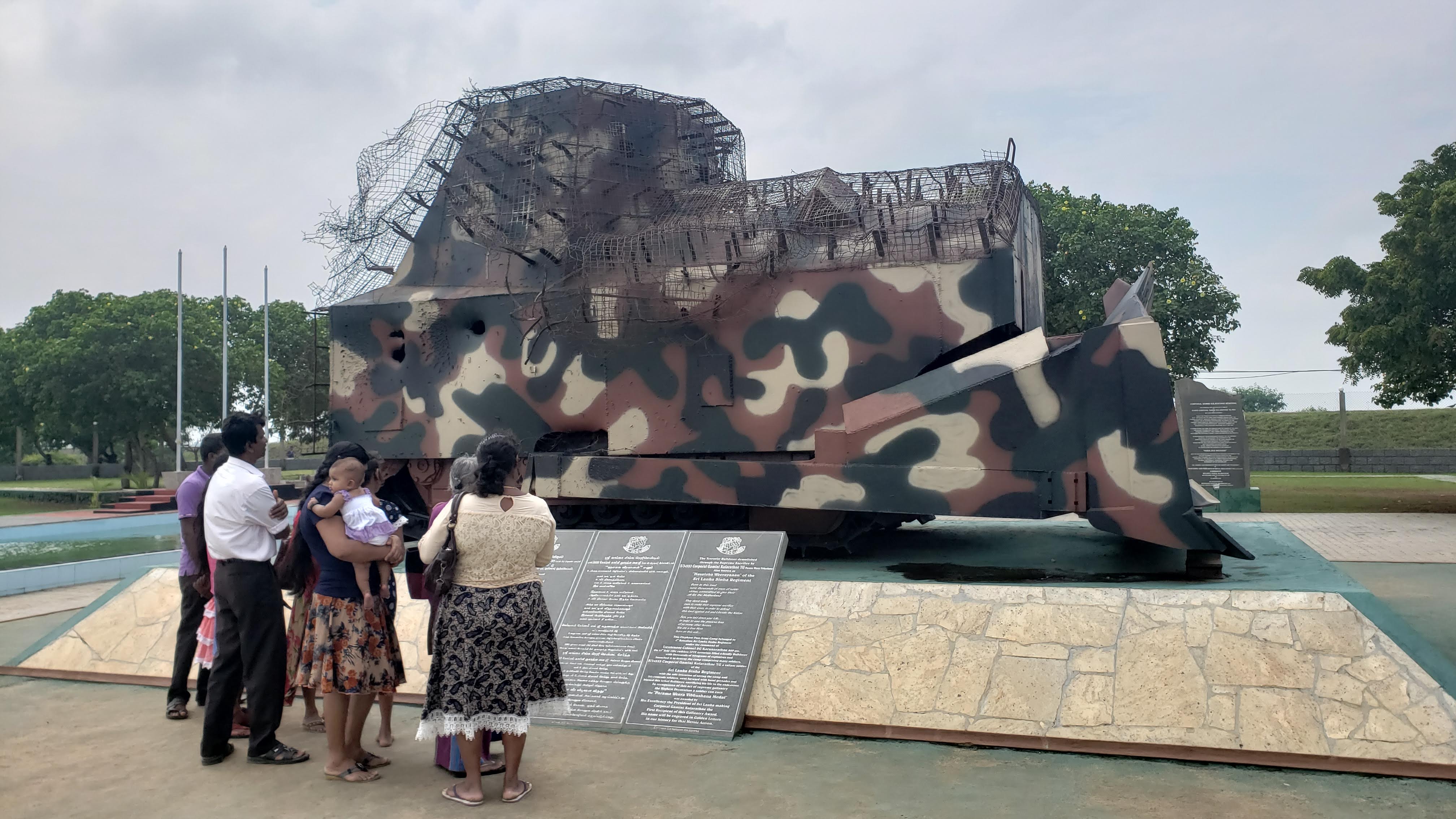
Visitors come to see the ruins of an LTTE tank in Kilinochi and a memorial dedicated to the Sri Lankan soldier who was killed fighting it. (Photo © Stephen Cook)
possibSinhalese tourists came by the busload to see relics of the war, a destroyed tank or water pipe, as well as newly-constructed monuments at nearby Elephant’s Pass, the site of heavy fighting referred to as the LTTE’s Maginot Line by military historian Paul Moorcraft.
When I visit, I manage to speak with a former LTTE-fighter. We sit at a table in an American-funded children’s park. directly across the highway from the Kilinochchi War Memorial: a giant cube shattered by a bullet from whence a lotus grows.
The flower is sacred to both Hindus and Buddhists and meant to symbolize peace – but according to my interviewee, it brings no comfort to the Tamil people.
“It’s a source of grief,” he says. “They are very carefully protecting their memorials and it’s a source of anxiety for us.”
A single soldier stands guard at the memorial. Its plaque tells a decidedly one-sided narrative, of the “humanitarian operation” that took place here and “paved the way to eradicate terrorism entirely from our motherland and restoring her territorial integrity and the noble peace.”
It makes no mention of civilian deaths – there is not yet any memorial for innocent Tamils caught in the crossfire.
“Those were our sisters and brothers, our children,” explains the man. “We do need memorials for them.”
Without memorials, without sites of remembrance to visit, the people are in “angst,” he says.
Under the new government, however, there has been some progress: two years ago Tamils were once again allowed to openly commemorate Maanveerar Naal, Great Heroes’ Day, which pays tribute to those who fought for the Tigers. The day is not without controversy, however, given its connection to the LTTE.
The man tells me the story of a banker who lit oil lamps and was punished with a transfer. He fears repercussions even for speaking with me.
“We still don’t have freedom,” he says. I think he refers to the military still occupies these lands and the central government favours the majority Sinhalese population.
The way tourism has developed in former conflict areas, especially accented by the memorial narratives here in the heart of tigerland, demonstrates the way the war lives on. Rather than recovery, the Northern and Eastern provinces stagnate economically as even the promises of tourism, so plentifully demonstrated in the south, has not yet proven a sustainable venture for many locals or the government has made little effort to prove to them the opportunity inherent. Meanwhile, the military and the SLTDA each in turn bar access to land and sea as they set up resorts whose benefits do not reach those who once freely fished and farmed these lands. How can a peace last when even something as seemingly innocuous as tourism is so tainted?
When the man asks for anonymity, he says something that reminds me of the fears expressed by the special rapporteur Ben Emmerson in his UN report, of the possible cost to the next generation if the politics of this country do not change.
The man tells me he will give his name freely “when we gain independence.”

